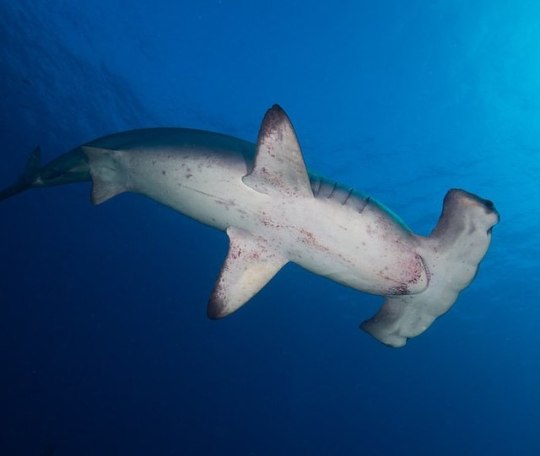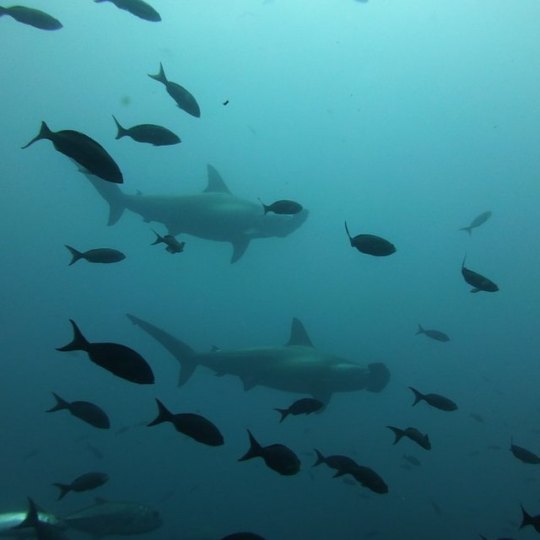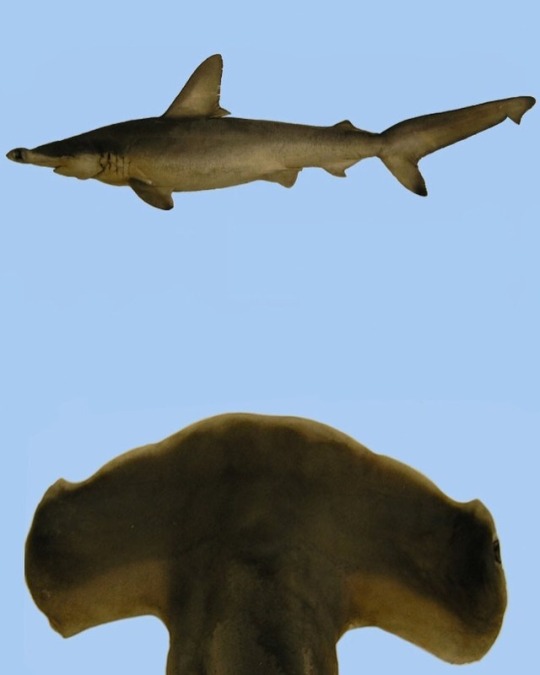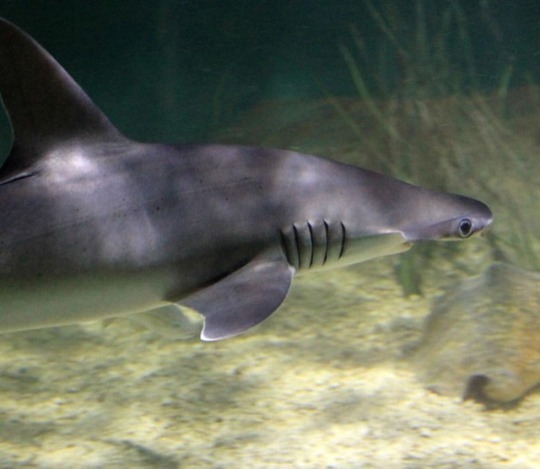#hammerheadprofiles
Photo

Species Profile No. 30: The Great Hammerhead (Sphyrna mokarran) The great hammerhead is the largest hammerhead species, usually reaching lengths of 11 feet, with the largest individual measuring a whopping 20 feet long! This species is also one of the most well-known. They eat a wide range of prey, from bony fishes to smaller sharks. Stingrays are one of their favorite foods! Great hammerheads are listed as Endangered. Females breed once every two years, giving birth to 20-40 pups after an 11 month long gestation. While they have large litters, most of the pups are likely eaten by predators, which include larger sharks. Great hammerheads are taken as targets and bycatch, and may be at greater risk than other species because they stick to tropical waters where there are more fisheries. Their fins are very large and high quality, which drives the demand to capture these sharks. They are protected by some finning bans, quotas, and pelagic shark protection plans, but it is unclear how helpful these measures have been to recovering their populations. Their population is still decreasing. As is often the case, the protections that exist for great hammerheads need better enforcement, and more research needs to be done on these incredible sharks. To help endangered sharks like the great hammerhead, please support Shark Advocates International and the IUCN Shark Specialist Group. ••••••••••••••••••••••••• #hammerheadprofiles #shark #sharks #hammerhead #hammerheadshark #greathammerhead #diversesharks #sharkeducation #savesharks #savethesharks #helpsavesharks #bycatch #overfishing #stopoverfishing #replacefearwithfacts #stopsharkfinning https://www.instagram.com/p/BxyhyNoBPdH/?igshid=yv63wid7tgsc
#hammerheadprofiles#shark#sharks#hammerhead#hammerheadshark#greathammerhead#diversesharks#sharkeducation#savesharks#savethesharks#helpsavesharks#bycatch#overfishing#stopoverfishing#replacefearwithfacts#stopsharkfinning
27 notes
·
View notes
Photo

Species Profile No. 29: The Scalloped Hammerhead (Sphyrna lewini) The scalloped hammerhead is one of the two most well-known hammerhead species, along with the great hammerhead. These two species are usually what people will envision if you say the word hammerhead! Scalloped hammerheads can be recognized by the shape of the front of their head, which has a scalloped edge, whereas great hammerheads have a smooth head. Scalloped hammerheads are listed as Endangered. Females can take as long as 15 years to mature, and pregnancy lasts for 9-12 months. Scalloped hammerheads have fairly large litters of 12-40 pups, but infant mortality is likely high, due to natural predators and fishing pressure. These sharks are captured, intentionally and accidentally, at all life stages. The main product derived from scalloped hammerheads is their fins, which are highly valuable. There may also be several genetically distinct groups of scalloped hammerheads, and some populations could be more threatened than others. More research is needed in this area. They are protected by some finning bans, quotas, and pelagic shark protection plans, but it is unclear how helpful these measures have been to recovering their populations. Whether their overall population is increasing or decreasing is unknown. As with many species of sharks, scalloped hammerheads are in need of more research and stricter protection regulation. To help endangered sharks like the scalloped hammerhead, please support Shark Advocates International and the IUCN Shark Specialist Group. ••••••••••••••••••••••••• #hammerheadprofiles #shark #sharks #hammerhead #hammerheadshark #scallopedhammerhead #diversesharks #sharkeducation #savesharks #savethesharks #helpsavesharks #bycatch #overfishing #stopoverfishing #replacefearwithfacts #stopsharkfinning https://www.instagram.com/p/BxtNL6HhuLd/?igshid=bjaiuxcdxcaj
#hammerheadprofiles#shark#sharks#hammerhead#hammerheadshark#scallopedhammerhead#diversesharks#sharkeducation#savesharks#savethesharks#helpsavesharks#bycatch#overfishing#stopoverfishing#replacefearwithfacts#stopsharkfinning
12 notes
·
View notes
Photo

Hammerheads are incredibly interesting and charismatic. Covering this unique family of sharks has been a joy, and we have now posted species profiles of every hammerhead species! This family includes two genera and nine species total. The winghead shark is the only member of the genus Eusphyra, with the other eight species being in the Sphyrna genus. The common trait of each of these species is their wide head, known as a cephalofoil, which gives them heightened senses and can be used to aid hunting! Of the nine species of hammerhead sharks, -One is Least Concern -One is not assessed -One is Data Deficient -One is Near Threatened -Two are Vulnerable -Three are Endangered Most members of the hammerhead family have slow reproduction and fins that are considered to be especially valuable and high-quality. With several not assessed/data deficient and vulnerable/endangered species, it is evident that hammerhead sharks are in desperate need of more research and conservation. Losing these sharks would be a true tragedy - all sharks are vital, but hammerheads have a special place in the hearts of many. If you want to learn more about each individual species, take a look through #hammerheadprofiles! https://www.instagram.com/p/ByEWHJgBFp0/?igshid=1p7nq907ragqv
10 notes
·
View notes
Photo

We’ve been covering hammerhead sharks lately, and some people may be wondering - why do these sharks have a hammer-shaped head in the first place? We’re going to answer this question and cover some hammerhead terminology, which will be especially helpful for our last hammerhead profile. The hammerhead’s hammer has a fancy scientific name - it’s called a cephalofoil! The cephalofoil has a few features that make it beneficial for the sharks. The most obvious feature is that it benefits their eyesight! Having such a wide head gives hammerheads an incredible field of vision, which helps them catch their prey. Sharks also have electricity-sensing organs called the ampullae of Lorenzini, which are found in high density on the front of sharks’ faces. The wide heads of hammerhead sharks provides more surface area for these electroreceptors, which enhances their ability to find prey. Some hammerheads, like the scalloped hammerhead, love to eat stingrays. They have actually been observed using their cephalofoil to wrestle and pin down stingrays to make it easier to eat them! ••••••••••••••••••••••••••••••• #hammerhead #hammerheadshark #hammerheadprofiles #shark #sharks #sharkfacts #cephalofoil #adaptation #anatomy https://www.instagram.com/p/Bx2g_SjhgK4/?igshid=1lqwcz54xs4e6
#hammerhead#hammerheadshark#hammerheadprofiles#shark#sharks#sharkfacts#cephalofoil#adaptation#anatomy
7 notes
·
View notes
Photo

Species Profile No. 25: The Carolina Hammerhead Shark (Sphyrna gilberti) When new species are discovered, it’s usually a small animal, like an insect or amphibian. So imagine the excitement of scientists when they discovered a new, large species of hammerhead! The first recorded Carolina hammerhead was found in 1967, but the researcher who found it - Dr. Carter Gilbert, the inspiration for the species’s binomial name - believed that he had simply found an abnormal scalloped hammerhead with fewer vertebrae. This wasn’t known to be a separate species till a physiological and genetic analysis was published in 2013, formally recognizing the Carolina hammerhead as its own species. The study can be found here: https://www.mapress.com/zootaxa/2013/f/zt03702p178.pdf The Carolina hammerhead looks identical to the scalloped hammerhead, which presumably means they grow to be similar sizes, and the two species are very closely related. Besides its physical traits and genetics, nothing is known about this shark. The Carolina hammerhead is yet to be assessed by the IUCN. Since it is similar to the scalloped hammerhead, an Endangered species, it’s possible that this newly discovered shark could be the victim of heavy overfishing. The only way we’ll be able to know is to research them, so make sure to support the research and conservation of poorly understood sharks by supporting the IUCN Shark Specialist Group and Shark Advocates International. ••••••••••••••••••••••••• #hammerheadprofiles #shark #sharks #hammerhead #hammerheadshark #carolinahammerhead #diversesharks #sharkeducation #savesharks #savethesharks #helpsavesharks #bycatch #overfishing https://www.instagram.com/p/BwdA-MDBbbg/?utm_source=ig_tumblr_share&igshid=madpy6k6lj5m
#hammerheadprofiles#shark#sharks#hammerhead#hammerheadshark#carolinahammerhead#diversesharks#sharkeducation#savesharks#savethesharks#helpsavesharks#bycatch#overfishing
9 notes
·
View notes
Photo

Species Profile No. 23: The Bonnethead Shark (Sphyrna tiburo) The bonnethead is a very small species of shark, and is often mistaken as a “baby hammerhead.” They are actually just a very small species of hammerhead! They usually grow to about 2-3 feet long, with 5 feet being the absolute maximum. They’re unique because they are actually omnivores, as they eat lots of seagrass and are able to digest it. They are also unique because the shape of their head is different between males and females, which is a trait that no other sharks are known to have! Bonnetheads are listed as Least Concern. They have a gestation period of only 4.5-5 months, which is one of the shortest gestation periods of any shark species. They give birth to 4-12 pups per litter. They are fished for fairly extensively, but it seems that their quick reproduction means that these fisheries are sustainable. Bonnetheads have a stable population! These sharks are a living example of a shark species that can be fished for sustainably, and shows that sustainable shark fishing is possible as long as fishing rates are limited to match rates of reproduction. Making sure that the bonnethead shark does not get fished too heavily is still important, and the IUCN notes that this species needs more management, as well as habitat protection. We hope that this little shark will continue to thrive! ••••••••••••••••••••••• #hammerheadprofiles #bonnetheadshark #shark #sharks #hammerhead #hammerheadshark #bonnethead #sharkeducation #conservation https://www.instagram.com/p/BwXiSBuBwNT/?utm_source=ig_tumblr_share&igshid=20sooaxq16l1
#hammerheadprofiles#bonnetheadshark#shark#sharks#hammerhead#hammerheadshark#bonnethead#sharkeducation#conservation
8 notes
·
View notes
Photo

Species Profile No. 27: The Smooth Hammerhead (Sphyrna zygaena) The smooth hammerhead is the second largest hammerhead species, and can grow up to 16 feet long. They eat rays, smaller sharks, bony fishes, and crustaceans. Smooth hammerheads are listed as Vulnerable by the IUCN. They have gestation periods of 10-11 months, and give birth to 20-50 pups, but the pups are vulnerable and often eaten by predators. Smooth hammerheads are targeted by fisheries, likely throughout their range, as well as being caught as bycatch. They have highly valuable fins, so they are one of the shark species that fisheries will remove the fins from and discard the rest of the shark. These sharks are included in some finning bans and protection programs, but further research is needed to understand whether these methods have been effective. Shark protection laws are often lacking in proper enforcement. To help obscure species like the smooth hammerhead, please support the IUCN Shark Specialist Group and Shark Advocates International. ••••••••••••••••••••••••• #hammerheadprofiles #shark #sharks #hammerhead #hammerheadshark #smoothhammerhead #diversesharks #sharkeducation #savesharks #savethesharks #helpsavesharks #bycatch #overfishing #stopoverfishing #replacefearwithfacts #stopsharkfinning https://www.instagram.com/p/Bwp3_1tBGsO/?utm_source=ig_tumblr_share&igshid=1mfeu7ppcak3u
#hammerheadprofiles#shark#sharks#hammerhead#hammerheadshark#smoothhammerhead#diversesharks#sharkeducation#savesharks#savethesharks#helpsavesharks#bycatch#overfishing#stopoverfishing#replacefearwithfacts#stopsharkfinning
7 notes
·
View notes
Photo

Species Profile No. 31: The Winghead Shark (Eusphyra blochii) The winghead shark has the most impressive cephalofoil of all the hammerheads! This shark is different enough from other hammerheads to be sorted into its own genus, Eusphyra, rather than being in the Sphyrna genus with the rest of its relatives. The width of the head is equal to around half of the shark’s body length! This means that all of the benefits of a wide head, from vision to electroreception, are magnified in the winghead. They also have elongated nostrils, which improves their sense of smell. The winghead is listed as Endangered by the IUCN. Females give birth to 6-25 after a gestation period of 8-11 months. They have one litter per year. Winghead sharks are overfished through much of their range, being targeted for meat, fins, and oil. They are also likely caught as bycatch as well. Their population is known to be decreasing. There is currently no species-specific protection for these sharks. To help endangered species like the winghead, please support Shark Advocates International and the IUCN Shark Specialist Group. ••••••••••••••••••••••••• #hammerheadprofiles #shark #sharks #hammerhead #hammerheadshark #winghead #wingheadshark #diversesharks #sharkeducation #savesharks #savethesharks #helpsavesharks #bycatch #overfishing #stopoverfishing #replacefearwithfacts #stopsharkfinning https://www.instagram.com/p/Bx5MJCHB6Bw/?igshid=wfj36qkg4qrf
#hammerheadprofiles#shark#sharks#hammerhead#hammerheadshark#winghead#wingheadshark#diversesharks#sharkeducation#savesharks#savethesharks#helpsavesharks#bycatch#overfishing#stopoverfishing#replacefearwithfacts#stopsharkfinning
3 notes
·
View notes
Photo

Species Profile No. 28: The Smalleye Hammerhead (Sphyrna tudes) The smalleye hammerhead lives in coastal, murky waters, which is likely why it has smaller eyes than other hammerheads. They feed on crabs, bony fishes, and newborn shark pups. Adult males and juveniles form large shoals, but adult females are solitary, so this species is an example of shark social behavior! The smalleye hammerhead is listed as Vulnerable by the IUCN. They have a gestation period of 10 months, and give birth to 5-12 pups per litter. This slow reproduction makes them vulnerable to overfishing. Smalleye hammerheads are caught by gillnet and artisanal fisheries. They face significant fishing pressure, but no conservation actions are in place for this species. To help obscure species like the smalleye hammerhead, please support the IUCN Shark Specialist Group and Shark Advocates International. ••••••••••••••••••••••••• #hammerheadprofiles #shark #sharks #hammerhead #hammerheadshark #smalleyehammerhead #diversesharks #sharkeducation #savesharks #savethesharks #helpsavesharks #bycatch #overfishing #stopoverfishing #replacefearwithfacts #stopsharkfinning https://www.instagram.com/p/BwuyDcaBGrR/?utm_source=ig_tumblr_share&igshid=mfw7tlsh8ktb
#hammerheadprofiles#shark#sharks#hammerhead#hammerheadshark#smalleyehammerhead#diversesharks#sharkeducation#savesharks#savethesharks#helpsavesharks#bycatch#overfishing#stopoverfishing#replacefearwithfacts#stopsharkfinning
4 notes
·
View notes
Photo

Species Profile No. 26: The Scalloped Bonnethead (Sphyrna corona) The scalloped bonnethead reaches lengths of only three feet, and may be the smallest species of the family! They live in inshore habitats, especially those that have soft bottoms, like sand, mud, and gravel. They can also be found in mangrove forests and estuaries. They eat a variety of foods like crustaceans, cephalopods, molluscs, echinoderms (the family of starfish, sea cucumbers, etc), and bony fishes. The scalloped bonnethead is listed as Near Threatened by the IUCN. Not much is known about these little sharks, but they are known to only two pups per litter. This species goes unreported within fisheries, but as a small inshore species it is very likely being fished for, and with such small litter sizes it is very vulnerable to overfishing. Nothing is known about its population, so more research is desperately needed to gain a better understanding of this species. They could be rapidly declining, but without a baseline population assessment, researches would have no way of knowing. To help poorly understood species like the scalloped bonnethead, please support the IUCN Shark Specialist Group and Shark Advocates International. ••••••••••••••••••••••••• #hammerheadprofiles #shark #sharks #hammerhead #hammerheadshark #scallopedbonnethead #bonnethead #bonnetheadshark #diversesharks #sharkeducation #savesharks #savethesharks #helpsavesharks #bycatch #overfishing #stopoverfishing #replacefearwithfacts https://www.instagram.com/p/Bwne3eJhNPB/?utm_source=ig_tumblr_share&igshid=1iik6kwsx5ljp
#hammerheadprofiles#shark#sharks#hammerhead#hammerheadshark#scallopedbonnethead#bonnethead#bonnetheadshark#diversesharks#sharkeducation#savesharks#savethesharks#helpsavesharks#bycatch#overfishing#stopoverfishing#replacefearwithfacts
3 notes
·
View notes